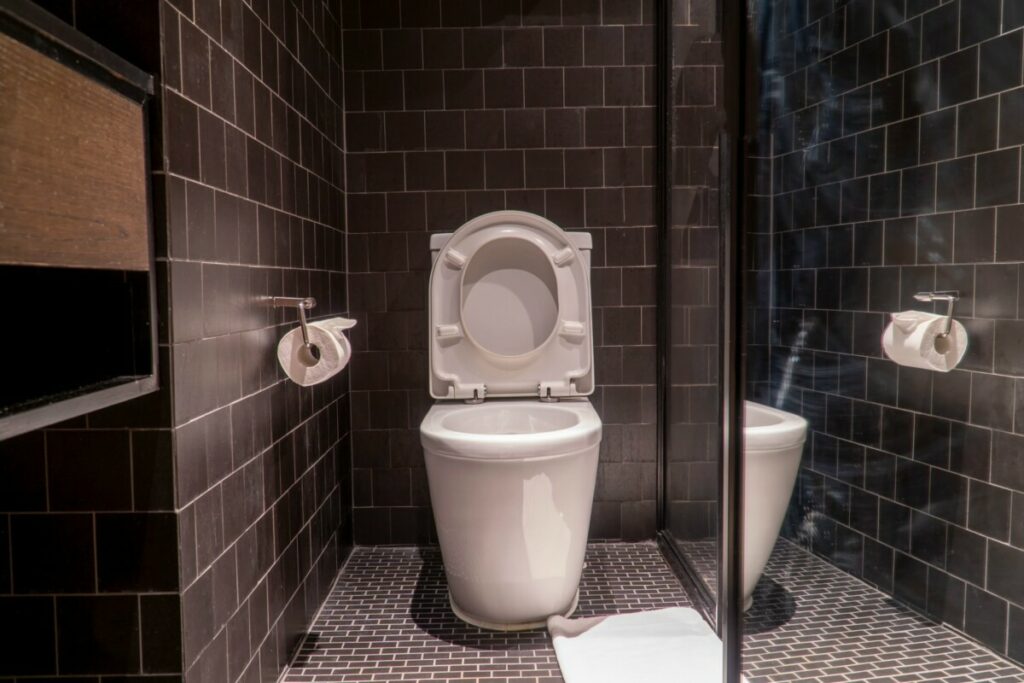This Is the Maximum Weight a Toilet Will Hold
Last Updated on September 19, 2022 by Alex Cubias
Do you ever wonder if you are reaching the weight limit a toilet can hold? Well, don’t worry—it is likely that you never will.
An average-sized toilet can hold a maximum of 1000 pounds, while a wall-hanging toilet can only hold a maximum of 500 pounds. This is due to the material used to build a toilet, its size, and how it is installed. However, the average toilet seat can only hold 300 pounds.
Continue reading to learn more about a toilet’s weight limit and how you can keep your toilet in prime condition for years to come.

Floor Mounted Weight Limit
A floor-mounted toilet can hold up to 1000 pounds, twice the weight limit of a wall-mounted toilet. This is due to the toilet having more support being installed on the ground. Toilets usually weigh between 50 and 150 pounds, so they can hold sometimes 10 times their weight limit.
Most modern-day toilets are made out of porcelain, which is a very durable and substantial material. It is easy to mold, which makes it easy to create toilets. Porcelain is inexpensive to work with, making toilets inexpensive as well.
Porcelain is also very easy to clean, which helps with toilet maintenance and keeping them in prime condition. Porcelain has worked for so long, and it doesn’t look like toilets will be made out of different materials anytime soon. Many of you may remember when toilets had wooden seats, but porcelain is much more durable and easier to keep in good condition. (Source)
If you are worried about being too heavy for a toilet, do not worry. The average human weighs below 200 pounds, a fifth of what a toilet can hold. If you are heavier, you could purchase a larger toilet or install an extra sturdy toilet seat.

Wall Mounted Weight Limit
Wall-mounted toilets are not as stable, since they are installed into the wall and are hanging, letting gravity put extra weight on the toilet already. Wall-mounted toilets can hold up to 500 pounds, which is still more than twice the weight of the average human. There is still no need to worry about reaching the weight limit when going out in public and possibly using a wall-mounted toilet.
Another material used to create toilets is steel, but steel toilets are mostly used for prisons. Steel is much more durable and substantial. Bathrooms outside of prisons don’t use steel toilets because they aren’t as aesthetically pleasing as porcelain toilets. They also change temperature easily; if it is super cold outside, you will be freezing while using the bathroom, and if it is hot outside, a steel toilet could be too hot to sit on.
Toilet Seat Weight Limit
Toilet seats are separate from the bowl of the toilet, so they have a different weight limit. Most toilet seats can hold up to 300 pounds. Toilet seats can be pretty durable if used normally.
Some newer toilet seats are plastic, so make sure that if you have a newer plastic toilet seat you check the weight limit on them. Most toilet companies don’t advertise the weight limit of the toilet or the seat, because it is never an issue. Most toilet seats are still made out of porcelain, so don’t worry.
Ways to Make Your Toilet Last
Toilets are meant to last for 50 years, but they often get replaced sooner than that for the aesthetic. It’s crazy how much the design and style of a toilet can date the house and change its value. Many people buy newer toilets to fit the new aesthetic of their homes and keep up with trends. Some toilets used to be different colors, and toilets were much smaller than they are today. (Source)
Since toilets can last for so long, you want to make sure they live up to their potential! The first thing you can do is make sure the toilets don’t reach their weight limit. This is pretty easy to follow, but some people try squatting on the toilet or standing on the rim of the bowl or the seat itself.
First of all, this is very dangerous. You could slip and get injured, or even worse, break the toilet. Toilets are also very unsanitary, so you don’t want to stand on the toilet and then walk all over your house, spreading those germs.
In other countries that don’t have modern toilets, they are used to squatting to go to the bathroom. When they visit America, they don’t understand that they can sit on the toilet to use the bathroom. So, they end up climbing on the toilet and squatting to use the bathroom. This damages the toilets much faster.
Some public bathrooms now have signs with a demonstration of how to use a modern toilet. It’s so interesting that not every culture lives the same way—we are all different in our own ways.

If you stand on a toilet, it will more likely crack the bowl, since the bowls aren’t designed to take all of someone’s weight at one pressure point but rather evenly distributed weight when people are sitting. If you stand on the toilet, it puts more pressure on it, and it is more likely to crack and break. Toilets last about 50 years, so don’t break them before then!
If it cracks and floods, that is just a pain, especially if the toilet is upstairs in the house and the water leaks down to the bottom floor. You then not only have to pay for a new toilet but for the damage and repair in your home. Another simple tip is to use cleaning products that are meant for toilets. This keeps the toilet materials in the best shape possible.
We may not think about it all the time, but toilets are very important for our environmental health. They help properly dispose of waste and make life more convenient. They are very durable with a max weight limit of 1000 pounds if the toilet is mounted into the ground. Toilets can last up to 50 years as long as they don’t reach the weight limit, aren’t stood on, and are cleaned properly.